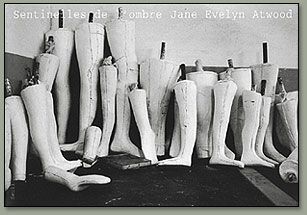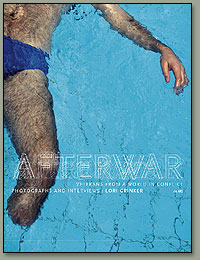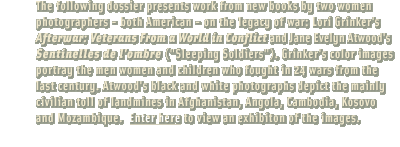| |
The twentieth
century was history’s bloodiest, as nationalism and competing
ideologies gained the technological prowess to destroy lives on a
scale never before imagined. And the century of the great wars was
also a century of great war photographers. Most, from Robert Capa
and David Douglas Duncan to Larry Burrows, Don McCullin and James
Nachtwey, were — like the overwhelming majority of combatants
— men.
The story these intrepid photographers so expert at capturing the
chaos of battle left largely untold is what happens after war?
What is conflict’s legacy on the individual and on society? What
are the economic, physical and emotional costs borne by the soldier
and the civilian? These essential and topical questions, today routinely
overshadowed by the spectacular drama of war, have been considered,
in different ways, by two women, Jane Evelyn Atwood and Lori Grinker,
both Americans. |

| Sentinelles
de l'ombre (Editions du Seuil 2004) |
|

| Afterwar:
Veterans From a World in Conflict (de.MO 2004) |
|
| |
Lori
Grinker’s Afterwar: Veterans From a World in Conflict
(de.MO 2004) surveys the life of former frontline combatants from
twenty-four conflicts throughout the world — men, women and children.
Through her portraits and accompanying interviews made over a fifteen-year
period between 1989 and 2004, she underscores the common experience
of all vets, whether professional soldiers or guerillas, volunteers
or forced conscripts, both during and after war . Likewise, all types
of wars are represented: wars of decolonialization or liberation,
world wars, civil wars, ethnic, religious and ideological wars. Documenting
the veterans’ path to battle, and the physical and psychological
wounds they suffered there, Grinker calls attention to the fact that
for the former combatant war never really ends.
Jane Evelyn Atwood, by contrast, focuses not on fighters but on the
scourge of landmines, whose victims are often civilians maimed long
after a particular conflict has ended. Her book, Sentinelles de
l’ombre — for which she also wrote the text — provides
a look at the brutal reality of these “sleeping soldiers,”
over 50 million of which are buried in 80 nations. Between 2000 and
2003, Atwood visited some of the most heavily-mined: Afghanistan,
Angola, Cambodia, Kosovo and Mozambique. Initiated with the support
of Handicap International, a major participant in the International
Campaign to Ban Landmines, which was awarded the Nobel Peace Prize
along with its coordinator Jody Williams, Atwood’s work reveals
the awful handiwork of these vicious and senseless weapons. |
• Order
Afterwar
• Order Sentinelles
de l'ombre |
 |
|







